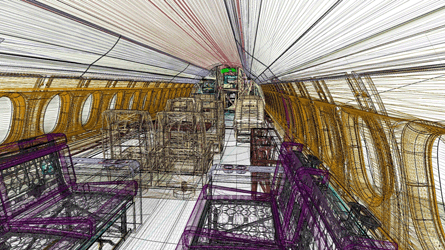French airframer Dassault could play a major role in defining paths for engines and avionics in business and commercial aviation when it selects the powerplant and cockpit vendors for the next generation of Falcon aircraft.
In December, the company said its latest goal for putting the super-midsize business jet into service is 2016. This is its second attempt at the new model after the economic situation in 2007 delayed its plan to finish what was then a Rolls-Royce RB282-powered jet by 2014. So far, only the landing gear manufacturer - Heroux Devtek - has been disclosed.
Although the SMS is a business jet, selection of the re-competed engines and a new avionics suite could have far-reaching consequences in the broader aviation community.
Flight International has learned that Dassault will make its avionics selection early in the new year, with competition down to either Rockwell Collins or Honeywell. Garmin, which launched itself into the large-aircraft (Part 25) market with a win in October for Cessna on the Citation Ten integrated avionics suite, does not appear to be in the final running for the SMS, according to those familiar with the programme.
 |
|---|
© Dassault |
A Honeywell win could signal a shift away from head-up displays in the advanced cockpit mindset, where a convergence of synthetic and enhanced vision systems will allow for reduced-visibility landings and ground operations, ultimately to zero cloud height and zero visibility (zero/zero) conditions, referred to as equivalent visual operations.
Typically, business aviation is the proving ground for such advanced safety and efficiency technologies, with airlines taking note and applying the technology later. At present, operators with an approved enhanced flight vision system with HUD can get "credit" to continue a Category 1 instrument approach below the standard 200ft (60m) decision height, where the pilot must see the runway environment with the naked eye, using the infrared image as displayed in the HUD.
At 100ft above touchdown, the pilot must have contact with the runway by eye. An RTCA special committee is developing the minimum requirements for reduced visibility and zero/zero systems, including the limits on the benefits to be gained by using HUD versus head-down displays (HDD) and the merits of having synthetic or enhanced vision or a combination of the two.
Committee officials say the groundwork and regulator approvals needed to operate in zero/zero conditions could come by 2012, but it may take longer for industry and operators to justify an investment in the technology.
Indications are that Honeywell has offered an HDD version of fused synthetic and enhanced vision. Adding weight to Honeywell's bid will be its head-down synthetic vision-capable systems already available as part of the Primus Epic-based EASy avionics suites for Dassault. Rockwell Collins has most likely proposed its Fusion flightdeck with a combined synthetic and enhanced vision system on the HUD. The first marriage of the two will come on Bombardier's Global Vision flightdeck, scheduled to be certificated and available in 2012 on the Global 5000 and Global XRS business jets. The company's HUDs are an increasingly familiar fixture in airline aircraft, with more than 3,000 Rockwell Collins head-up guidance systems (HGS) in service worldwide. A Flight Safety Foundation study funded by Rockwell Collins said an HGS with flightpath guidance would have helped pilots avoid nearly 400 of 1,000 accidents studied from 1995 to 2007.
NEW ENTRANT
Regarding engines, a win for new business aviation entrant Snecma on the SMS could shape a new world order for powerplants. Snecma, fan and low-pressure systems provider for the world-renowned CFM56 engine, has been aggressively pursuing a number of business jet programmes since 2007, when it introduced the 9,500-12,000lb-thrust (42-53kN) Silvercrest turbofan.
A win for the Silvercrest could mean the traditional threshold where a simpler, lower part count centrifugal compressor engine makes sense takes a leap upward, perhaps to the regional jet or small airliner. Officials say they have tested the engine core to significantly higher levels that what is commonly considered the upper limit for a centrifugal-based compressor - about 12,000lb thrust.
Meanwhile, other competitors in the larger engine regime (greater than 10,000lb thrust) are advancing with axial designs that maintain commonality between business aviation and commercial airline customers.
Pratt & Whitney Canada's PW800-series turbofan engines, originally selected by Cessna for the stalled Columbus business jet, are gaining operational experience through prototype engine tests that are under way for the 24,000lb-thrust PW1524G geared turbofan engine for the Bombardier CSeries 110- to 125-seat airliner. A first engine, instrumented to focus on low-pressure elements, was rapidly approaching its targeted 100h test programme at the end of the year, while a second engine, instrumented to analyse the core, is set to begin testing in 2011. The PW1524G and PW800 share a common core architecture.
Airbus has already selected P&W's PW1000G geared turbofan as an option for the re-engined A320. Boeing, as 2010 ended, had not declared its ambitions on an re-engining programme, but it is thought that it continues to study both geared turbofan and CFM International Leap-X engine configurations for an upgrade on the tried and true 737.
GE's business jet offering, the Tech X engine, is building time in the commercial market through core testing for CFM's Leap-X1C engine for the Comac C919. Bombardier chose the Tech X for its new ultra-long-range Global 7000 and Global 8000 models, set to enter service in 2016 and 2017, respectively.
Like the P&W offerings, the Leap-X and Tech X share a common core, which is GE's offering in the CFM joint venture. Testing on the first "eCore" is complete and a second, more advanced, core with architecture similar to the final product will begin in 2011.
Source: Flight International
















